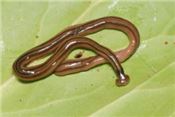Hammerhead Worms Slithering Into Kentucky
DR. JONATHAN L. LARSON
LEXINGTON, KENTUCKY
Recently, we have received several inquiries about hammerhead worms and their prevalence in Kentucky. These predaceous flatworms look like something out of a bad 1950’s sci-fi movie, sometimes described as snake-like with a hammer for a head. They have also been in the news a lot lately after some social media posts went viral and people began to notice them. So, what are they and should anything be done about them?
Identification
These particular land planarians are distinct looking. Typically they are light brown or honey in color. Species may also have varying numbers of dark stripes that run down their back. For example, Bipalium kewense (also known just as hammerhead flatworm) has five dark lines, while Bipalium pennsylvanicum or the three-lined flatworm has… three lines. The species vary in size but they can be over 10 inches long. Their most distinguishing characteristic is the sickle or half-moon shaped head that gives the group their name. They are also slimy looking, flat in profile, and legless.
What is the issue?
Some flatworms are native to the U.S. and Kentucky, but others, like the two mentioned above, are introduced and potentially invasive.
Broadly, this group is predaceous, and they can feed on snails, slugs, and earthworms. Their potential to harm earthworm populations could hurt the beneficial services that earthworms provide by decomposing various materials in nature.
In addition, there are some medical and veterinary concerns. Some species produce tetrodotoxins, which are potent and most famously associated with pufferfish. That doesn’t mean that contact with these odd critters will automatically kill you, but caution should be exercised with them. Handling them should be avoided but if it does occur, wash your hands afterwards. They can also be a host for rat lungworm, similar to snails and slugs. This parasite can be passed to humans when eating undercooked or raw snails, slugs, freshwater shrimp, crabs, and frogs. Because of the toxin and possible parasites, if you were considering it, definitely do not eat hammerhead worms!
Are they in Kentucky?
The short answer is yes, these have been found in the state. In 2020 there were two confirmed samples, one from Letcher County and one from Calloway County. In 2021 there was at least one inquiry from Pulaski County and in 2022 a sample was confirmed from Fayette County. These counties are spread fairly far apart, which could indicate they could be found in other Kentucky counties.
These worms are most likely to be found in warm, damp environments.
They might be spotted under rocks and logs or in leaf litter.
Sightings of hammerhead worms may increase on rainy days, particularly if the rainy day occurs after a dry period.
Management
It is hard to recommend a broad management tactic that would rid an area of these worms. However, if you do spot one in your garden or near your home, there are some simple things you can do using products likely already in your home.
First, don’t try to physically destroy or cut up the worms.
Segmenting them can result in reproduction. Part of their body does naturally “fall off” and turn into a new individual, so don’t help them with that process. You can however use salt on them, like you would a snail or slug. It will destroy them, but you need to be cautious about not getting salt in the soil around your plants.
Spritzing the hammerhead worm with vinegar or citrus oil can also kill it. If you need to isolate the treatment, you can pick up the hammerhead worm with tweezers or gloved hands and put in a sealable bag, then apply the salt or vinegar. ∆
DR. JONATHAN L. LARSON: Entomology Extension Specialist, University of Kentucky

Figure 1: Hammerhead worms are slimy, legless, predatory worms most noted for their hammer or half moon shaped heads.
They feed on earthworms, snails, and slugs.
Photo: © Jean-Lou Justine, Leigh Winsor, Delphine Gey, Pierre Gros, and Jessica Thévenot

Figure 2: UK entomologists have received multiple reports of hammerhead worms in Kentucky. People should exercise caution around them, and avoid handling the worms with their bare hands, if at all possible. The worms may be found in damp areas and appear more frequently after a rain.
Photo: Whitney Cranshaw, Colorado State University, Bugwood.org